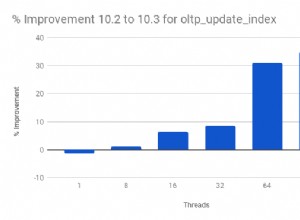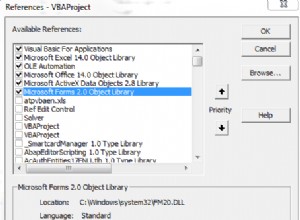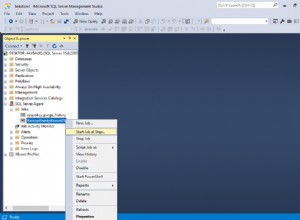Leia
Please Note no fundo primeiro. Tudo bem, você está de volta. Criação de um Stored Procedure para recuperação de hierarquia do tipo recursiva.
Observe que você não queria isso por níveis, mas isso pode ser feito facilmente.
Esquema:
create table category
( category_id int not null auto_increment primary key,
category_name varchar(40) not null,
parent_id int null, -- index on this column not a shabby idea
unique key (category_name)
);
insert category(category_name,parent_id) values ('car',null),('food',null); -- 1,2
insert category(category_name,parent_id) values ('ford',1),('chevy',1),('fruit',2); -- 3,4,5
insert category(category_name,parent_id) values ('economy',3),('escort',6),('exhaust',7); -- 6,7,8
insert category(category_name,parent_id) values ('chassis',7),('loud',8),('banana',5); -- 9,10,11
-- ok granted I could have explicity inserted category_id to make it more obvious
Criar procedimento armazenado:
-- drop procedure showHierarchyBelow;
delimiter $$
create procedure showHierarchyBelow
(
catname varchar(40)
)
BEGIN
-- deleteMe parameter means i am anywhere in hierarchy of role
-- and i want me and all my offspring deleted (no orphaning of children or theirs)
declare bDoneYet boolean default false;
declare working_on int;
declare theCount int;
declare findFirst int;
select ifnull(category_id,0) into findFirst from category where category_name=catname;
CREATE TABLE xx_RecursishHelper_xx
( -- it's recurshish, not recursive
category_id int not null,
processed int not null
);
if isnull(findFirst) then
set findFirst=0;
end if;
insert into xx_RecursishHelper_xx (category_id,processed) select findFirst,0;
if (findFirst=0) then
set bDoneYet=true;
else
set bDoneYet=false;
end if;
while (!bDoneYet) do
-- I am not proud of this next line, but oh well
select count(*) into theCount from xx_RecursishHelper_xx where processed=0;
if (theCount=0) then
-- found em all
set bDoneYet=true;
else
-- one not processed yet, insert its children for processing
SELECT category_id INTO working_on FROM xx_RecursishHelper_xx where processed=0 limit 1;
insert into xx_RecursishHelper_xx (category_id,processed)
select category_id,0 from category
where parent_id=working_on;
-- mark the one we "processed for children" as processed
update xx_RecursishHelper_xx set processed=1 where category_id=working_on;
end if;
end while;
delete from xx_RecursishHelper_xx where category_id=findFirst;
select x.category_id,c.category_name
from xx_RecursishHelper_xx x
join category c
on c.category_id=x.category_id;
drop table xx_RecursishHelper_xx;
END
$$
Testar proc armazenado:
call showHierarchyBelow('food');
+-------------+---------------+
| category_id | category_name |
+-------------+---------------+
| 5 | fruit |
| 11 | banana |
+-------------+---------------+
call showHierarchyBelow('car');
+-------------+---------------+
| category_id | category_name |
+-------------+---------------+
| 3 | ford |
| 4 | chevy |
| 6 | economy |
| 7 | escort |
| 8 | exhaust |
| 9 | chassis |
| 10 | loud |
+-------------+---------------+
call showHierarchyBelow('ford');
+-------------+---------------+
| category_id | category_name |
+-------------+---------------+
| 6 | economy |
| 7 | escort |
| 8 | exhaust |
| 9 | chassis |
| 10 | loud |
+-------------+---------------+
call showHierarchyBelow('xxx');
-- no rows
Observe que apenas modifiquei esta Resposta meu de alguns meses atrás para suas necessidades.
Observe
O acima é apenas para fins ilustrativos. Em uma situação do mundo real, eu nunca criaria tabelas em um proc armazenado. A sobrecarga de DDL é significativa. Em vez disso, eu usaria tabelas não temporárias pré-existentes com um conceito de sessão. E limpe-o das linhas para a sessão concluída. Portanto, não tome o acima como mais do que um espantalho, esperando por você para torná-lo mais performático como tal. Pergunte se isso é confuso.




